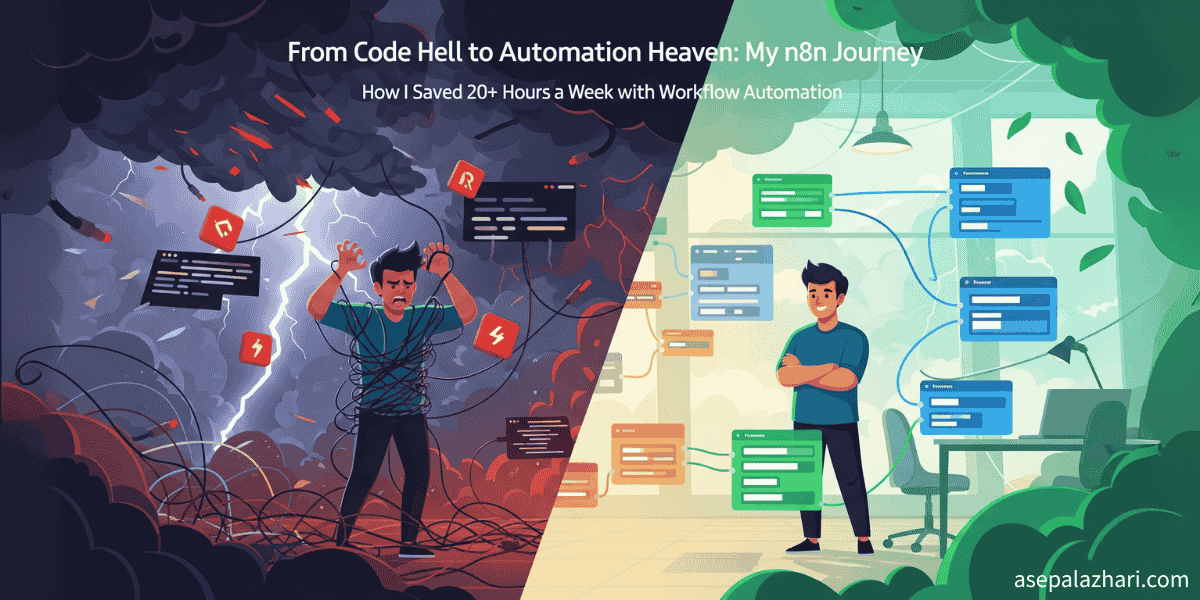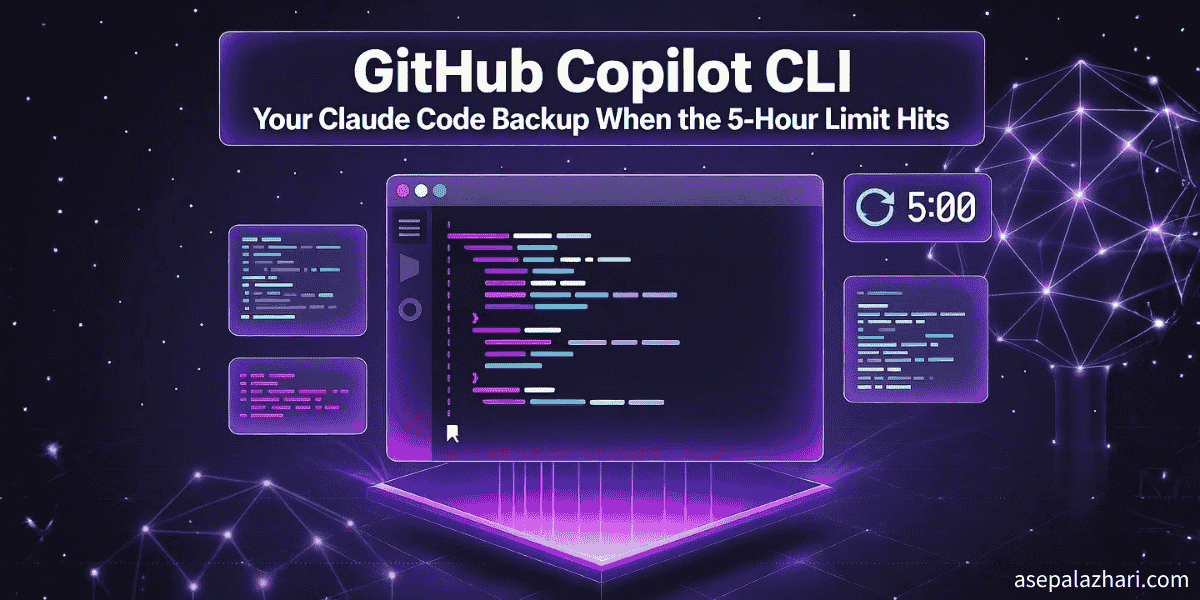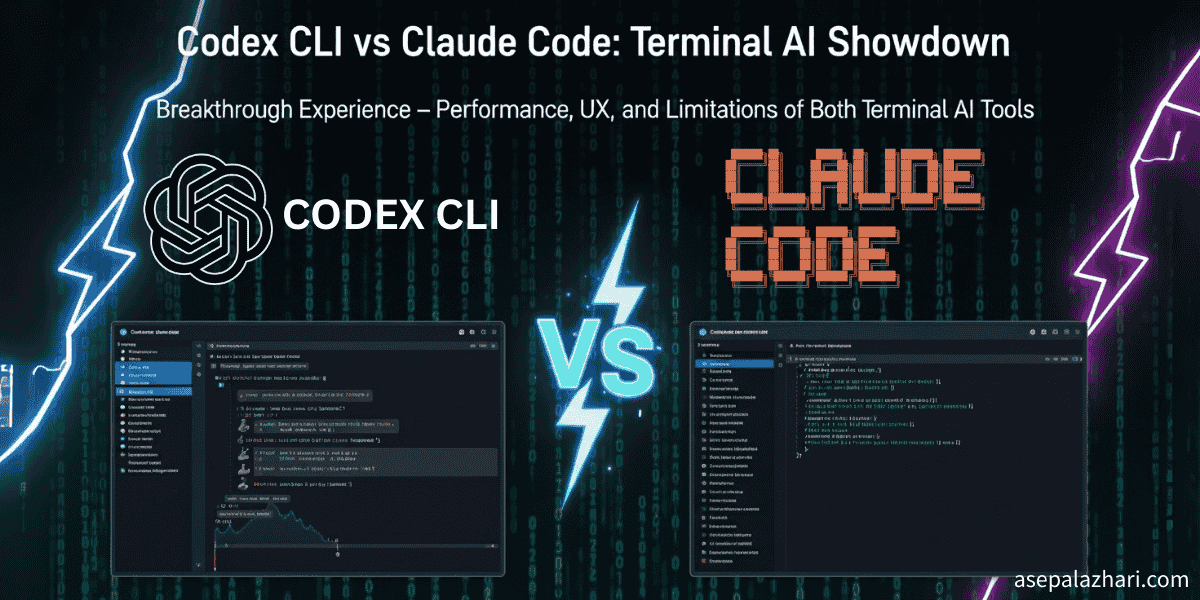From Code Hell to Automation Heaven: My n8n Journey
How I escaped the endless cycle of manual API coding and discovered a workflow automation tool that changed everything—saving 20+ hours weekly.

I was deep into another late-night coding session, staring at my screen with tired eyes, debugging yet another API integration. My coffee had gone cold hours ago, and I was questioning every life choice that led me to this moment.
The task? Simple enough: create an automation where receipts and invoices sent via Telegram would automatically be saved to Google Drive, have their details extracted and logged in Google Sheets, then get summarized by AI and stored in Google Docs. The reality? Days of wrestling with multiple Google APIs, Telegram Bot configurations, AI service integrations, file handling, and countless edge cases I never anticipated.
Sound familiar? If you’re a developer who’s ever built “simple” automations from scratch, you know this pain intimately. You know the feeling of spending more time on plumbing than the actual business logic. You know the frustration of maintaining brittle API integrations that break every time a third-party service updates their endpoints.
That night became my breaking point—and my breakthrough moment. It’s when I discovered n8n, and everything changed.
The Breaking Point: When Manual API Development Becomes a Nightmare
Let me paint you a picture of my pre-n8n life. Every automation request from my team felt like starting from scratch:
- Week 1: Building a Telegram bot to receive and process document uploads
- Week 2: Creating a workflow to extract data from receipts using OCR and AI
- Week 3: Developing an automated system to organize files in Google Drive and update Google Sheets
Each project followed the same exhausting pattern: research APIs, write authentication logic, handle rate limiting, implement error handling, write tests, deploy, and then maintain when things inevitably broke.
The real kicker? Most of these “custom solutions” were solving problems that thousands of other developers had already solved. I was reinventing the wheel, over and over again.
The Hidden Costs Nobody Talks About
Here’s what I didn’t account for when choosing the “just build it yourself” approach:
Time Investment: What seemed like a “quick 2-hour task” consistently turned into multi-day projects. Authentication alone could eat up half a day.
Maintenance Overhead: APIs change. Services update their endpoints. Rate limits get adjusted. Each integration became a ticking time bomb requiring constant babysitting.
Context Switching: Jumping between different API documentations, testing environments, and debugging tools fragmented my focus and killed productivity.
Knowledge Silos: When I inevitably moved on to other projects, my custom integrations became black boxes that only I understood.
Also Read: MCP with Claude Desktop: Transform Your Development Workflow
Enter n8n: The Visual Revolution
My first encounter with n8n happened during a particularly frustrating week. I needed to create a workflow that would:
- Receive receipts and invoices via Telegram
- Automatically save files to organized folders in Google Drive
- Extract key information using AI and OCR
- Log extracted data in Google Sheets
- Generate summaries and store them in Google Docs
Traditionally, this would have meant building multiple API integrations for Telegram Bot API, Google Drive API, Google Sheets API, Google Docs API, plus integrating with an AI service for document analysis, setting up file processing pipelines, and creating robust error-handling mechanisms. I estimated about two weeks of development time.
With n8n, I had it working in under two hours.
The difference wasn’t just speed—it was the entire mental model. Instead of thinking in terms of endpoints, request/response cycles, and error codes, I was thinking in terms of workflows. Each step was visual, testable, and immediately understandable.
The Drag-and-Drop Advantage
What makes n8n truly special isn’t just that it’s visual—it’s that the visual interface actually makes complex logic clearer. When I look at my workflows, I can immediately understand:
- What triggers the automation
- What data transformations happen at each step
- Where errors might occur
- How different paths branch based on conditions
Compare this to scrolling through hundreds of lines of API integration code, trying to trace the logic flow. There’s simply no contest.
Real-World Impact: The Numbers Don’t Lie
Since switching to n8n 1 months ago, I’ve tracked some interesting metrics:
Development Speed: What used to take 2-3 days now takes 2-3 hours on average.
Maintenance Time: From 4-6 hours per week maintaining various integrations to maybe 30 minutes checking workflow health.
Error Rate: Significantly lower, thanks to n8n’s built-in retry mechanisms and error handling.
Team Adoption: Non-technical team members can now understand and even modify simple workflows—something impossible with custom-coded solutions.
A Recent Success Story
Last month, my team needed to automatically:
- Process expense receipts sent through Telegram
- Automatically categorize and save files to specific Google Drive folders
- Extract vendor names, amounts, and dates using AI
- Log all transaction details in Google Sheets for bookkeeping
- Generate monthly expense summaries in Google Docs
Old me would have spent weeks building this integration, probably involving multiple serverless functions, complex file processing pipelines, and custom AI integration logic.
New me had it running in n8n within an afternoon, complete with error handling, retry logic, and detailed logging.
Also Read: Mastering Automated Docker Tagging in GitLab CI/CD: A Practical Guide
The Technical Deep Dive: Why n8n Works
Single Source of Truth
One of n8n’s biggest advantages is centralization. All my automations live in one place, with unified monitoring, logging, and credential management. No more hunting through multiple repositories or servers to understand why something broke.
Built-in Integration Ecosystem
n8n comes with 500+ pre-built nodes covering everything from popular SaaS tools to databases and custom APIs. Each node handles the tedious stuff—authentication, rate limiting, proper error responses—so I can focus on business logic.
Also Read: Cursor vs. VS Code vs. Windsurf: Best AI Code Editor in 2025?
The Code Nodes Escape Hatch
When I need custom logic that goes beyond the standard nodes, n8n’s Code nodes let me write JavaScript directly in the workflow. It’s the perfect hybrid approach: visual for the common patterns, code for the unique requirements.
// Example: Custom data transformation for receipt processing in n8n
const processedItems = items.map((item) => {
const data = item.json;
// Extract and categorize expense data
const category = categorizeExpense(data.vendor, data.description);
const isRecurring = checkRecurringPattern(data.vendor, data.amount);
return {
...data,
category,
isRecurring,
processedAt: new Date().toISOString(),
quarterlyTotal: calculateQuarterlyTotal(data.amount, category),
};
});
return processedItems;Self-Hosting Freedom
Unlike Zapier or Microsoft Power Automate, n8n can be self-hosted. This means:
- No vendor lock-in: My workflows aren’t trapped in someone else’s platform
- Cost control: I pay for hosting, not per workflow execution
- Data sovereignty: Sensitive data never leaves my infrastructure
- Customization: I can modify n8n itself if needed
Cost Analysis: The Economics of Automation
Let’s talk money. Here’s a realistic breakdown of costs for a small team running 50+ automations:
Traditional Development Approach
- Initial Development: 40 hours × $75/hour = $3,000
- Monthly Maintenance: 10 hours × $75/hour = $750/month
- Annual Cost: $12,000+
n8n Self-Hosted Approach
- Setup Time: 4 hours × $75/hour = $300
- Monthly Hosting: $20/month (VPS)
- Monthly Maintenance: 1 hour × $75/hour = $75/month
- Annual Cost: $1,440
Savings: Over $10,000 annually for just one developer’s automation needs.
The Zapier Comparison
For equivalent functionality, Zapier’s professional plan costs $599/month—over $7,000 annually. Plus, you’re limited by their execution quotas and available integrations.
With self-hosted n8n, there are no artificial limits. Your only constraints are server resources and imagination.
Future Horizons: What’s Next
The n8n ecosystem continues to evolve rapidly. Recent additions that have me particularly excited:
AI Nodes: Native integration with OpenAI, Anthropic, and other AI providers makes it trivial to add intelligence to any workflow.
Better Error Handling: The new error workflow feature lets me build sophisticated recovery mechanisms without writing complex try-catch logic.
Performance Improvements: The latest versions handle high-volume workflows much more efficiently.
The IoT Integration Dream
As someone deeply interested in IoT, I’m eagerly awaiting better integration with platforms like Tuya Smart Home. The ability to trigger workflows based on sensor data, control smart devices, and create complex home automation scenarios—all from the same visual interface I use for business workflows—is incredibly compelling.
For now, I’m making do with HTTP nodes and custom APIs, but native IoT support would be transformative.
Lessons Learned: When NOT to Use n8n
Honesty time: n8n isn’t perfect for every scenario. Here’s when I still reach for custom code:
High-Performance Requirements: For workflows processing thousands of items per second, custom solutions often perform better.
Complex Business Logic: While Code nodes help, some algorithms are easier to develop and test in a traditional IDE.
Strict Compliance Requirements: Some industries require specific audit trails and security measures that are easier to implement in custom solutions.
Team Expertise: If your team is primarily backend developers who live in IDEs, the learning curve might not be worth it for simple integrations.
The Transformation: From Code Monkey to Workflow Architect
The most profound change isn’t technical—it’s mental. I’ve shifted from thinking like a code monkey to thinking like a workflow architect.
Instead of asking “How do I implement this API integration?” I ask “What business outcome am I trying to achieve?”
Instead of getting lost in implementation details, I focus on the big picture: What data flows where? What triggers what? What should happen when things go wrong?
This shift has made me more valuable to my team and more satisfied with my work. I’m solving business problems, not just technical puzzles.
Also Read: Astro & shadcn/ui: A Guide to Building High-Performance UI Components
Getting Started: Your First Steps
If you’re convinced to give n8n a try, here’s my recommended approach:
- Start Small: Pick one simple automation you’ve been putting off
- Use n8n Cloud: Try the hosted version first to avoid setup complexity
- Join the Community: The n8n Discord is incredibly helpful for beginners
- Think in Workflows: Don’t try to replicate your existing code patterns
Pro tip: Don’t migrate everything at once. Keep your existing integrations running while you experiment with n8n versions. This lets you compare approaches without breaking production systems.
Final Thoughts: The Liberation of Letting Go
Making the switch from manual API development to n8n felt like learning to use a dishwasher after washing dishes by hand for years. Sure, there’s some initial setup and learning curve, but once you experience the freedom, there’s no going back.
The hours I used to spend on API plumbing are now invested in higher-value activities: understanding business requirements, designing better user experiences, and actually solving problems instead of fighting with infrastructure.
If you’re still writing custom API integrations for every automation need, I challenge you to question whether that’s really the best use of your time and talent. Sometimes, the most elegant solution isn’t the one you build from scratch—it’s the one that lets you focus on what truly matters.


